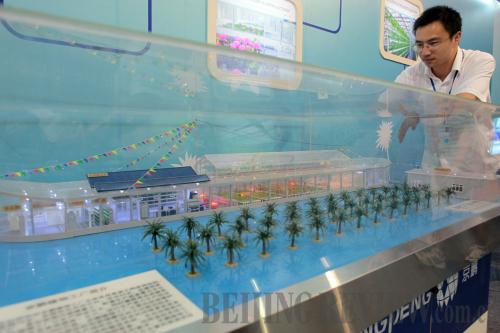|
 |
|
NEW MODEL: A plant factory model on display at Beijing International Modern Agricultural Exhibition on June 28 (LUO WEI) | Chinese scientists have also independently developed technologies to test and control the ingredients of nutrient fluid and its recycling. These technologies not only keep the plants well nourished but also save water and nutrients.
"In addition, sterilization has been a bottleneck in research about closed circulation nutrient fluid systems," said Zhou. "Multiple techniques are used in the sterilization process. First, sand filtration methods are used to remove residues and suspended matter to make nutrient fluid more transparent, then ultra-violet rays and shortwave ultra-violet rays (UV-C) in a vacuum are used in combination with ozone for quick, efficient and broad-spectrum sterilization and elimination of inorganic and organic pollutants from the nutrient fluid."
Since they grow in a clean environment and are free of pesticides, vegetables produced in a factory can be eaten without washing. Moreover, they are nutritious and palatable. They are real "green" vegetables.
Green energy
"The plant factory is powered by heat pumps, which is a significant technological breakthrough that has reduced the consumption of carbon-rich fossil fuels such as coal and oil and cut greenhouse emissions," said Zhou.
Heat pump technology is a new way of generating energy. A heat pump draws energy from its surroundings, including water, air and soil, and converts it into usable energy. The heat pump technology used in the plant factory is environmentally-friendly and energy-efficient. As no combustion is involved, a heat pump does not emit noxious gases such as sulfur dioxide or particles.
"We have also independently developed sensors to monitor the leaves' temperature and the stem or fruit's growth. Through these sensors, we can get data about environment conditions, and build models to evaluate energy consumption and the effect of environment control," Zhou said.
Solar power is also used in the plant factory to provide low-carbon green energy. "We have a 15 kw photovoltaic power generating system, so the key parts of the factory can function normally when normal electricity supply is disrupted or even after three days of rain or snow", Zhou said.
The high operating cost of a plant factory has been an obstacle to its widespread implementation. Zhou said the introduction of new technologies and alternative energy sources helped to significantly lower the cost.
Man-made "sun"
All living things depend on the sun for their growth. Yet in the plant factory in Tongzhou, plants grow under both sunlight and artificial light sources. The artificial light sources, primarily light emitting diode (LED) lights, are installed on the shelves where plants grow.
Last year, mainland China's first LED-lighted plant factory was successfully developed by the Institute of Agricultural Environment and Sustainable Development of the China Academy of Agricultural Sciences, and has been put into operation in the Changchun Agricultural Expo Park, in northeast China's Jilin Province.
Five years ago, Yang Qichang, a research fellow with the institute, learned Europeans were doing research on using LEDs as light sources in closed plant cultivation systems. He realized replacing fluorescent lights with LED lights would be a significant future direction.
"Although plants are exposed to all spectra of sunlight, including red, blue, ultraviolet and infrared rays, experiments demonstrate the wavelengths of light absorbed by plants are mostly (more than 60 percent) red and blue," Yang said. He said he believed an artificial light source with the right mix of red and blue rays could meet plants' growth need and not affect their quality.
As LED light used in daily life differed significantly from that needed for a plant factory, Yang and his assistants contacted several related research organizations in China, and developed the right LED equipment for plants. | 